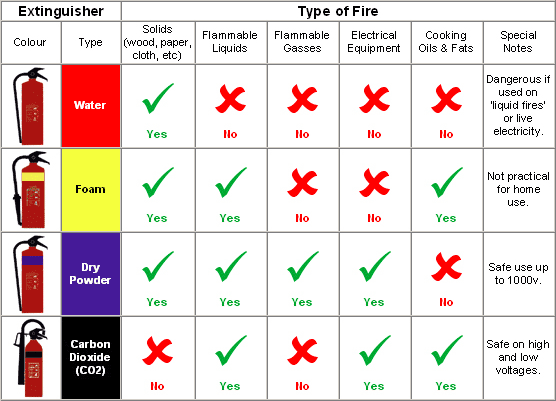
A fire extinguisher is a homeowners first line of defense when fire erupts. These handy tools could help save your belongings as well as lives. While amazing tools not all fire extinguishers are created equal. Choose the wrong tool for the job and you could end up making it even worse!
There are 5 classes of extinguishers all of which are specially suited for a particular type of fire.
OSHA Provides us with a great break down of extinguisher classes and uses.
Class A – Ordinary Combustibles – Fires in paper, cloth, wood, rubber, and many plastics require a water type extinguisher labeled A.
Class B – Flammable Liquids – Fires in oils, gasoline, some paints, lacquers, grease, solvents, and other flammable liquids require an extinguisher labeled B.
Class C – Electrical Equipment – Fires in wiring, fuse boxes, energized electrical equipment, computers, and other electrical sources require an extinguisher labeled C.
Class D – Metals – Fires involving powders, flakes or shavings of combustible metals such as magnesium, titanium, potassium, and sodium require special extinguishers labeled D.
Class K – Kitchen Fires – Fires involving combustible cooking fluids such as oils and fats.
Having 5 different classes of fire extinguishers sure does make it hard on the homeowner to always be prepared. Fortunately for homeowners the 3 most common house fires are covered by class A,B, or C and multi-class extinguishers that can cover all 3 perils are readily available!
Although I wouldn’t want to send you into a fight unprepared. Using a fire extinguisher properly isn’t as easy as you might think. Be sure to always have an escape plan, small fires can get out of hand quickly.
PASS is the best way to remember proper fire extinguisher usage.
Pull the pin. This releases the operation lever and acts as a safety to prevent unwanted discharge of the extinguisher.
Aim low. Always aim at the base of a fire, at the combustible material, and stop the fire at it’s source.
Squeeze the lever activating the extinguisher.
Sweep from side to side across the base of the fire being sure to cover the area until the fire is extinguished.
Accidents do happen and it’s helpful to be prepared for the worst. Talk to your local insurance agent and be sure you and your belongings are protected. They may advise you to take a photo inventory of your home to make it easier to replace your belongings in the event of a loss. But above all stay safe! Your stuff can be replaced with the proper homeowners policy you cannot!

